Taking some time to make and document color mixes is the best way to learn how to mix colors instinctively. Playing scales on the piano trains the ear, making color mixes trains the eye. Color scales are my favorite way to record my color mixes but I encourage you to come up with your own system for keeping track of your color mixing experiments. Here are a few ideas from my studio drawers to get you started.
Color Swatches
I started documenting my mixes with 2″ x 2″ swatches and ended up making a series of fan decks with two primary mixes for all the Fimo primaries. The top photo shows the Carmine, Burgundy, and Red Fimo fan decks I made by mixing the reds to yellows and to the complementary green. After baking the swatches, I wrote the formula on the back, drilled holes in the corners and used a head-pin to hinge the swatches into fan decks. The second photo shows the Fimo swatches that I used as the palette for the Fable Vessel series. The third photo shows a collection of the different types of swatches I’ve used over the years to document colors mixed with white. The first batch is Fimo, the second is Premo, the third is Premo using the Watercolor Technique. I keep these swatches loose and stored in wooden boxes so I can pull them out when I need color inspiration.
Color Templates
Before I switched to color scales, I sometimes documented mixes by inserting the colors into holes punched in templates made from gray clay. To get the lines and the patterns for cutting holes, I drew up the templates on the computer and made copies to transfer the design to the raw clay. I then cut out the holes with a circle cutter and baked the template before adding the color mixes. This technique proved to be way too labor intensive for me . . . but it might be right up your alley.
Color Scales
Color Scales came about when I needed an easier way to organize my mixes and see all the possibilities at a glance. The top photo with the round beads shows some of the first color scales I ever made. They were made in Fimo around 1994 and each scale was strung on wire so that I could mix and match them for different primary combinations. I ended up with over 40 two-color scales that could be interchanged to get the palette I wanted. The second photo shows some of the Fimo color scales going to white and black. The third photo shows a few bead strands that I made for project palettes; the bicone bead strand was made with Fimo, the other two are Premo. The last photo shows three bead strands that I made to document double primaries in Premo. The orange scales were made from Cad Yellow, Zinc Yellow, Cad Red and Fuchsia. For the green scales, I used Cobalt, Ultramarine, Cad Yellow and Zinc Yellow. The purple scales used Cad Red, Fuchsia, Cobalt and Ultramarie.
As you can see, I never bothered to come up with one perfect way to keep track of all the test mixing I do in the studio. The important thing is to do it – document it if you can – and move on to the next project!
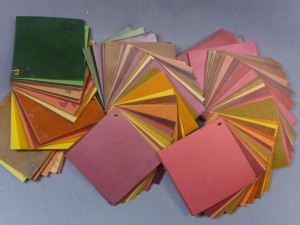

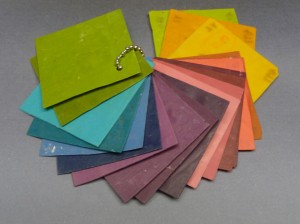
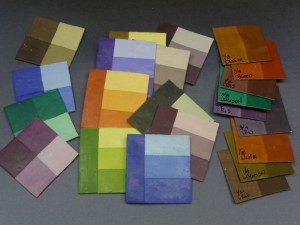
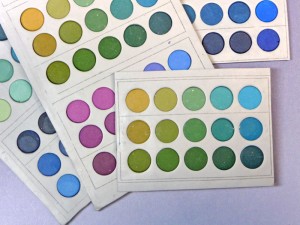
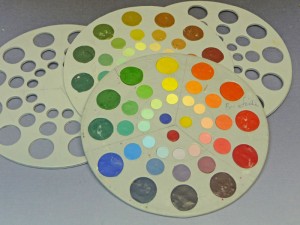
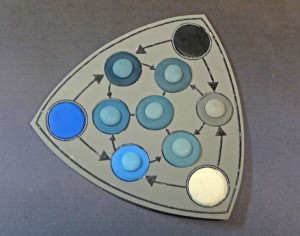
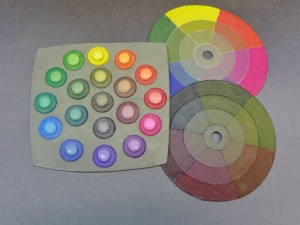
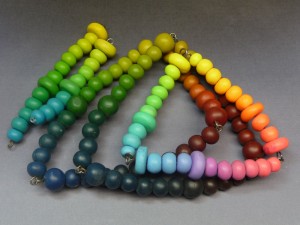
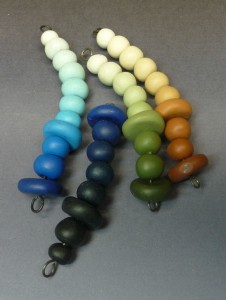
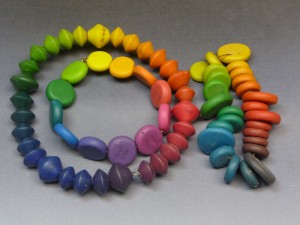
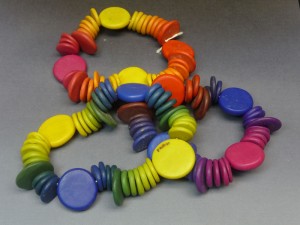

February 17, 2010 at 6:54 pm
Maggie – I’ve purchased your book and it is the most valuable tool in my polymer clay arsenal. You and Lindly have written the most concise reference on color families I have ever seen. Coming from the world of acrylic paint you’ve opened my eyes to why I couldn’t get the hang of mixing clay colors. Then you top that with true inspirations to create even for a polymer novice like me! I would like to make copies of your color wheels, but my local copy store will not reproduce any copyrighted material. Any ideas where I could print out copies of your family wheels? You are so generous to post lessons on the web – THANK YOU. And to you PC artists – both novice and veteran – purchase the book “Polymer Clay Color Inspirations.” Your PC artwork will never be the same.
Jessie
February 7, 2010 at 1:14 pm
Maggie, I was shown your book by my good friend and fellow color enthusiast, Beverly Ash Gilbert (beverlygilbert.blogspot.com/) – and I was so loving the results of lush, rich color in your mixes. You’ve produced a great video here. So impressive – and so fun to see what can be done with mixing color!
December 15, 2009 at 9:35 pm
I Have just discovered Fimo – five large blocks purchased for $10.00 at a garage sale. Now … I’m addicted to it. Easy to work with, the magic of the colours as they literally morph before my eyes, unfortunately difficult to purchase living in the bush of N.W. Ontario. Your new book will be my ‘colour class’ for the new year. Your colour beads look good enough to eat!!! I need to touch them.
Thank you for sharing your expertise.
Deby
December 3, 2009 at 12:37 pm
I love your color mixes, and I have your and Lindly’s new book. I have not had the chance to do any of the lessons but I will. I have also watched every one of your color scale video’s. I wish I could have them all on one DVD so I could watch them one right after the other, along with the hand out sheets to do the lessons on. It has excited me to mix up such beautiful colors, and for you to share your knowledge with others and not ask for money before you share,is just so awesome. So thanks for your generosity and for being a giving person. Lynn W.